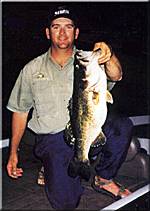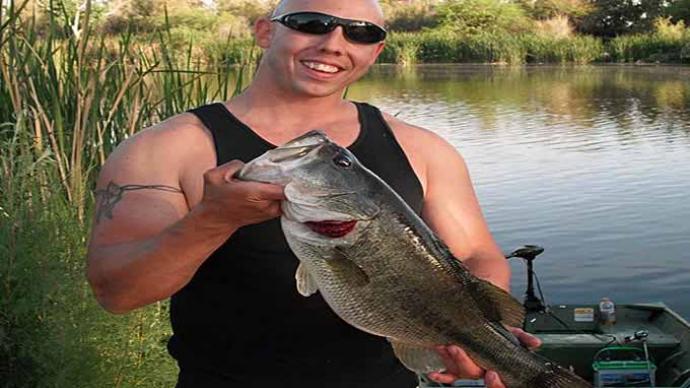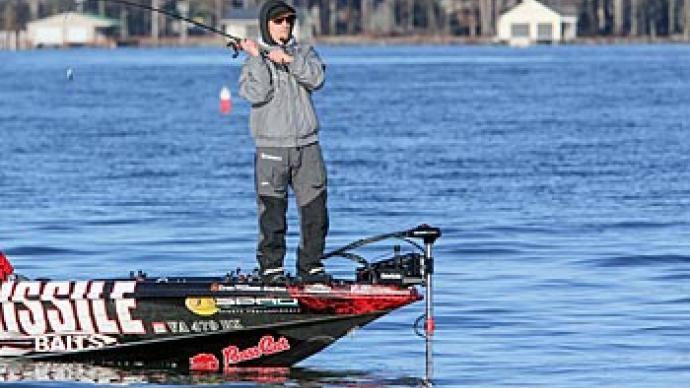
Clear water has always been considered difficult to fish. So what do you think of when someone mentions clear water? Spinning rods, light lines, and deep water? Sissy tackle is required, according to most country-fried southern bassers. Maybe, but not all bass in clear water live in deep water, and some of the bass that live in clear water can break that fairy wand with the flick of a tail.
Here in central Texas, the Highland Lakes chain is blessed with not only incredible numbers of both largemouth and Guadalupe bass but some giant bass that have been caught in recent years.
The Colorado River feeds the Highland Lakes, which begin at Buchanan, then Inks, LBJ, Marble Falls, Travis, Austin, and on to Town Lake, which runs through downtown Austin. These lakes have very clear water, so for this article, I will refer to these lakes, but by no means are these techniques limited here. I learned some of these techniques while reading about the Western bass fishing scene. Then, I applied them to my local lakes to work anywhere there is clear water.
Clear water can be defined as at least five-foot visibility to as much as 20. Clear water allows the bass to go almost anywhere in the lake. In addition, because of low water fertility, the deep water has ample oxygen.
To consistently score on clear-water bass, you must match your tackle to the current conditions and patterns. As mentioned, spinning tackle plays a vital role in clear-water fishing for several reasons. Light line can be critical with lure presentation and generating more strikes due to reduced visibility. It is also imperative to scale the size of the lures down, and smaller lures cast much easier on spinning tackle. But not all situations will call for such light tackle.
Fishing boat docks or flooded brush may call for heavier baitcasting tackle. When pitching jigs and soft plastics to docks, I may use 17- or 20-pound test because I feel that the strike is a reaction bite and the bass did not have time to inspect the line. All that is seen is the bait falling and the bass inhaling it. When fishing around flooded brush, I will go to 15-pound test in a low visibility color such as green. Due to the extreme fluctuations of lake Travis since the drought last year, we have been blessed with an abundance of shoreline cover, such as bean bushes, willows, and buck brush which has provided the bass with incredible shallow water cover. In the past, bass have used rocky points and docks for cover and ambush sites, but the flooded bushes have provided the finest fishing we have seen in years. When bass in clear water have ample shallow cover, they will move up into shallow water and are much easier to catch.
Lure selection for clear-water lakes should first be based on the daily conditions, which in turn dictate the position of the bass. Cloudy, windy days will put bass on the feed in clear water. The wind is your friend on the Highland Lakes, but use common sense when navigating in rough water, and believe me, it can get rough here at times. Windblown main lake, secondary points, and pockets are always a good bet when baitfish are present. Also, watch for blue herons on windy points; they will tell you that shad are present.
Spinnerbaits and jerkbaits are great search lures on windy days. Scale your spinnerbait down to a quarter-ounce, and you will get more bites. As for skirt colors, it is essential to keep it natural and trim the skirt and add a trailer hook. More than half of the bass I catch on spinnerbaits in clear water will be hooked on the trailer hook. Use a small #4 treble as a stinger for the smaller spinnerbaits. Nickel and hologram blades work great because flash is the most essential characteristic of a spinnerbait in clear water.
Suspending jerkbaits are another excellent tool for locating bass in clear water. Something about a bait that just sits there after moving erratically triggers bass on the Highland Lakes. For years, anglers have been modifying their jerkbaits with various weights to suspend them. Those baits were a best-kept secret for a long time, but too many tournaments were won on them for people not to notice. Now every major manufacturer offers a suspending model. Experiment with your retrieve until the bass tell you how they want it, but most will invariably strike it on the pause.
In the warmer months, soft plastics will be the best choice because the bass feed more, so it is time to slow your presentation down. Soft plastic jerkbaits like the Zoom Fluke and Big Bite Baits Jerk Minnow will replace the hard jerkbait. Unfortunately, these baits are deadly when fished around flooded brush and shallow docks.
Keep your colors natural such as shad or watermelon, and fish the bait weightless in water less than 20 feet deep. Most clear-water lakes here are full of threadfin and gizzard shad, crawfish, and various sunfish. Learn what the bass are feeding on and match that natural bait with a soft plastic lure. As for crawfish, the skirted Twin Tail grubs work great here and have been known to catch some big bass. The bass in clear, rocky central Texas lakes feed on crawfish year-round. Rig this bait on a football head for fishing open water ledges or points. When fishing docks or brush, I will rig it Texas style with a screw-in type sinker. Try a tube bait in the same areas of the skirted grub is not getting strikes. Again, remember to keep your colors natural such as watermelon and green pumpkin.
One significant advantage of fishing clear water lakes is the ability to sight fish. Not only in the spring for bedding bass, but cruising bass in marinas are just as exciting to catch as spawners. On the Highland Lakes, bass have two choices for shade and cooler temperatures, deep water or overhead cover. Overhead cover might be an isolated dock or an entire marina. That's right, some of the best bass fishing in central Texas is found right under the feet, or maybe boats, of hundreds of people. Marinas provide everything a clear-water bass needs to survive—shade, cover, food, and, surprisingly, a lack of fishing pressure.
The bottoms of the boat stalls are covered with algae, which attracts the shad that attracts the bass. Marinas, however, can be difficult to fish effectively. There are so many cables, crossbars, and tight spaces that it only rewards the best casters. Learn to skip a bait under a dock like a stone. Spinning tackle is easier, but baitcasting is more precise. It just takes more practice. Sometimes I will get on my knees to access a particular opening between a dock and a boat. Choose a lure that skips quickly, like a weightless soft jerkbait or a grub. If you can get into the very far reaches of a dock, then you will catch bass that other anglers will miss.
Another way to score on clear-water lakes is to fish at night. On heavily pressured clear water lakes such as Travis, the bass will become less cautious and roam shallower water when feeding at night. There are hundreds of lighted docks on any of the Highland Lakes; any of these can hold bass as long as a little brush is under them. Texas-rigged worms and spinnerbaits are good choices for night fishing.
The lower end of Lake Travis has dozens of deep main-lake ledges that can hold incredible numbers of bass during the summer and winter. This is classic structure fishing and requires using and understanding good electronics. Most of these ledges have at least a 20-foot break, and some drop as much as 50 feet. This is Guadalupe bass country, and these hard-pulling little bass dominate the deep structure. When you catch one, you may catch a hundred if the timing is right. A deadly technique is counting down a 1/8-ounce smoke glitter grub on light spinning tackle and hopping it off the ledge.
Topwaters are always most effective in clear water. Some of my most memorable topwater trips have occurred during the middle of the day here on Travis. Something about a walk-the-dog type bait attracts bass in clear water. Zara Spooks, Sammys, and Chug Bugs are excellent choices in central Texas. Clear is my preferred color, but bone works excellent on cloudy, overcast days. Do not be afraid to throw the topwater in a hundred feet of water if bass and bait are present. Some of my biggest Travis bass have come on topwaters at marina breakwaters in water deeper than the Gulf of Mexico.
Bass will suspend under this cover and let the wind push shad into the area. Clear water bass will also suspend over long points and ledges and rise to hit a properly presented Spook.
Try some of these patterns the next time you fish here or in any clear water. Make long casts, scale your lure sizes down, and keep your colors natural. Do not be afraid to fish shallow if there is ample cover present.
BassResource may receive a portion of revenues if you make a purchase using a link above.




